Seven Young Artists
| July 2, 2011 | Post In LEAP 8
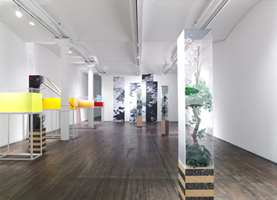
1. TOBIAS MADISON
Twenty-five year-old Swiss artist Tobias Madison’s recipe for artmaking combines minimalist sculpture with slick 80’s design and a touch of branding and glitch aesthetics. The artist, who was recently the subject of solo exhibitions at New York’s Swiss Institute and Kunstverein München, has been known to pour gallons of Vitamin Water into hyperdesigned fish tanks (which Madison convinced the company to sponsor) and present prints of scanned DVDs— feats of which the artist manages to pull off with finesse. Madison also has an enfant terrible streak, embarking in the summer of 2009 on a road trip from Switzerland to China, stealing Radisson Hotel flags bearing the Obama-esque slogan “Yes I Can!” along the way. The flags made their way onto stretcher bars for Madison’s paintings. The artist is also a founding member of New Jerseyy, an artist’s run space in Basel, Switzerland, which he operates alongside curator Daniel Baumann, Emanuel Rossetti, and Dan Solbach.

2. SARA VANDERBEEK
Sara VanDerBeek could be understood as a collector or curator as much as an artist— she gathers newspapers, photographs and other ephemera, the likes of which often end up in various constellations in her artwork. In her studio, VanDerBeek creates intricate sculptures from her gathered ephemera and photographs them, soon after dismantling the creations never to be seen again. The somber, historicity-evoking sculptures range in configuration from Calder-inspired mobiles to Noguchi-esque statues. Curiously, although the 3D fabrications would likely have a greater market presence than that of her photographs, they’re never seen as autonomous works. VanDerBeek’s penetrating gaze is focused straight upon the contemporary affects of the photographic image by way of carefully assembling and juxstaposing relics from the past. Beyond VanDerBeek’s success as an artist, launching her first solo museum exhibition at the Whitney in 2010, she also co-founded and co-directed the New York gallery Guild and Greyshkul with her brother, Johannes, and fellow artist Anya Kielar from 2003 to 2009.
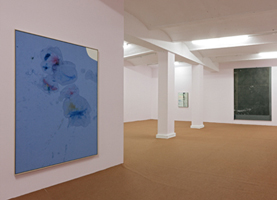
3. SERGEJ JENSEN
To install his 2009 solo exhibition at Berlin’s KW, Danish artist Sergej Jensen stripped the walls constructed the previous show, letting its rugged remains provide the mise en scene for his paintings. An artist of minimal aesthetics, Jensen frequently “makes do” with found components, though his choice materials appear anything but uncalculated. While a rainbow bleeds through a canvas evoking Cy Twombly, diaphanous gauze pieces are stitched together on stretcher bars recalling Eva Hesse. Jensen clearly appreciates art history but is reticent to hit us over the head with over-the-top citations so common in MFA-bred painting. His compositions bring to mind the mid-twentieth-century Japanese movement Mono Ha, in which artist worked to underscore a material’s essential aesthetic experience. Jensen’s long list of recent solo exhibitions include mountings at the Hammer Museum, Los Angeles; the Aspen Art Museum in Colorado; White Cube, London; Galerie Neu, Berlin, KW Institute, Berlin; and Anton Kern, New York.
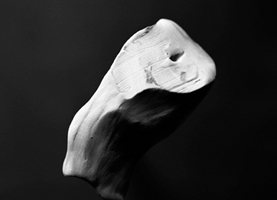
4. ERIN SHIRREFF
Through sculpture, photography, and video, Erin Shirreff prompts her viewers to consider the mutability of perception. With a few slights of hand her photographs make bread dough appear as planetary orbs while frail sculptures of compressed ash evoke a cratered lunar surface. Shirreff bears the unique ability to turn dust into mountains and mountains into dust, reminding her viewers that images are not always as they appear. Graduating from the prestigious MFA Sculpture program at Yale in 2005, 2010 saw Shirreff included in exhibitions hosted by three major New York based institutions including the Metropolitan Museum of Art, the Sculpture Center, and MoMA P.S.1. At P.S.1 her work bore a heavy presence in their quintennial survey of contemporary art “Greater New York.”
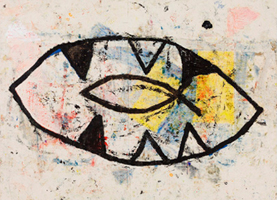
5. JOE BRADLEY
Joe Bradley, a painter dubbed as “slacker” and “durr” by the press, is a hot topic, and one that critics love to hate. Ranging from geometric robots to stick figures and oil stick abstractions, his oeuvre of goofy minimalist paintings continually reinvents itself. A beautifully rendered amorphous cock and balls could be understood as Bradley’s take on contemporary minimalist painting. Since his first exhibition at CANADA in New York City’s Lower East Side in 2006, the price of Bradley’s work has soared 1100% from a meager $6,000 to upwards of $70,000. Within the first two months of 2011, Bradley has launched three different New York based galleries including his veteran CANADA, the venerable Gavin Brown, and Brooklyn’s the Journal gallery.
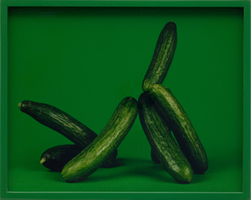
6. ELAD LASSRY
Israeli-born Los Angeles-based artist Elad Lassry has a knack for combining the sleek with the uncanny. His strikingly rendered videos, photographs and collages appear similarly to publicity headshots, low-budget commercials or 70’s magazine advertisements, often employing Technicolor hues and restrictive color palettes. A photograph of seven precariously balanced and sumptuously lit cucumbers appear on a kelly green background in a kelly green frame; a young Czech woman unabashedly gazes straight into the camera with an unsettling smile; three transparent, highly reflective water bottles disappear upon a black backdrop, appearing at once lustrous and sinister. Processing original and found images through both digital and analog technologies, Lassry works to divorce the purpose and context of the image from its origins, prompting the viewer to take an extended look at the photograph. Recent exposure includes a major monographic exhibition at the Contemporary Art Museum of St. Louis while smaller shows have been mounted at the Whitney Museum of American Art, the Art Institute of Chicago, and Kunsthalle Zurich.
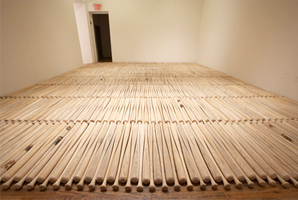
7. DAVID ADAMO
Performance artist and sculptor David Adamo is famous for using materials less frequently seen in the art world: baseball bats, canes, and axes. With a penchant for the emotional, Adamo whittles these instruments into specters of their former selves. Baseball bats and axes, once imbued with an overt sense of power, are transformed into toothpick-thin rods surrounded by their shaved exoskeletons. Decimated canes would snap under the weight should it be put to use. The force and precision with which Adamo creates these objects is immediately apparent. The artist’s performative work casts a similar emotive temperament. In a recent durational piece, the artist stood before John Singer Sargent’s Portrait of Madame X at the Metropolitan for an entire day. Adamo, originally from upstate New York, currently resides in Berlin. He was included in the 2010 Whitney Biennial.

